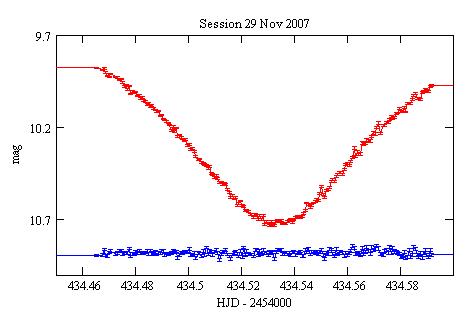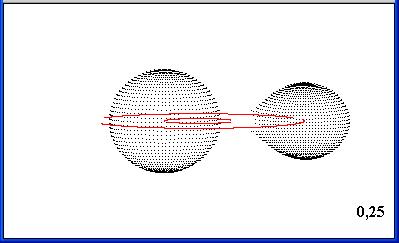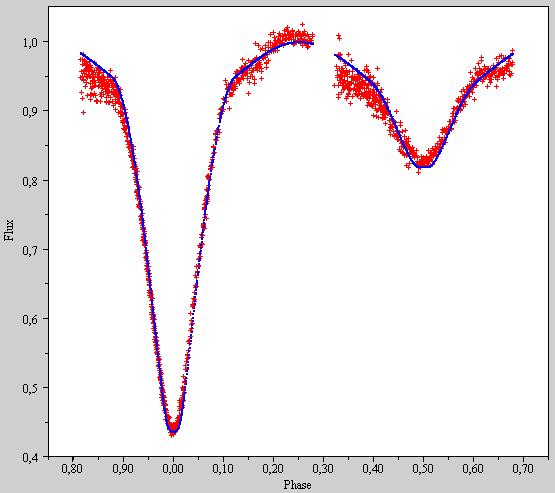WX Eri / V1241 Tau: an eclipsing semi-detached binary system
Observed: 15 Oct, 29, 30 Nov, 13, 16 Dec 2007, 1, 23 Jan 2008
Michel Bonnardeau
25 Jan 2008
Abstract
Light curves of this eclipsing, semi-detached binary system with a period of 0.8d are presented and are modeled with BinaryMaker3. No evidence for a pulsating star in this system is found.
Introduction
V1241 Tau (WX Eri in the previous edition of the GCVS) is a binary system with an orbital period of 19.6h. One of the star was suspected to be pulsating (a delta Scuti type star).
Observations
The observations were carried out with a 203mm SC telescope, a Clear filter and a SBIG ST7E camera (KAF401E CCD). 1569 usable images were obtained, each with an exposure duration of 30s.
For the photometry, the comparison star is GSC4709-01022 with an assumed unfiltered magnitude of 10.2. The check star is GSC4709-01298 with a measured average magnitude of 11.500, an average 1-sigma statistical uncertainty of 0.006mag and a standard deviation of 0.014mag.
An example of a light curve:

Red: V1241 Tau, Blue: the check star shifted by -0.8mag. The error bars
are +/- the 1-sigma statistical uncertainties.
Phase analysis
According to the GCVS, the ephemeris t(E) = T0+P0*E for the primary eclipse is:
T0 = 2,427,531.687 HJD (4 Apr 1934)
P0= 0.823,270,38 d
But when I fold my observation with this ephemeris,
the primary eclipse is 23.8mn late. A new ephemeris is then:
T0 = 2,454,434.533 HJD (29 Nov 2007)
(or P0=0.823,270,88 d for the 32,678 cycles between the T0 of the GCVS
and my observations. Note that Srivastava & Kandpal (1986) reported
P0=0.823,270,76.).
This gives the phase plot:

The phase coverage of my observing sessions:

Modeling with BinaryMaker3
I model my phase plot with the BinaryMaker3 software. I use the parameters of the binary system from Arentoft et al (2004). All my parameters are HERE.
The results are:

The binary system at orbital phase 0.25. The red ellipses are the orbits,
the inclination being 86°.

Red crosses: the observations, Blue dots: the model.
V1241 Tau is suspected to hold a pulsating star. But the BinaryMaker3 model fits fairly well my observations, with no significant need for more variability. The residuals between the observations and the BinaryMaker3 model are of 0.015mag on average, with a standard deviation of 0.019mag. This confirms the non-detections of a pulsating component of Arentoft et al (2004) (down to 8millimag) and of Pigulski & Michalska (2007).
References
Arentoft T., Lampens P., van Cauteren P., Duerbeck H.W., Garcia-Melendo E., Sterken C. (2004) A&A 418 249.
Pigulski A., Michalska G. (2007) arXiv:astro-ph/0703614.
Srivastava J.B., Kandpal C.D. (1986) Ap & Sp Sc 121 301.
Technical notes
Telescope and camera configuration.
Computer and software configuration.
Modeling with BinaryMaker3.
|
|
|||
|
|||
|
|
|||
|
|
|||
|
|||
